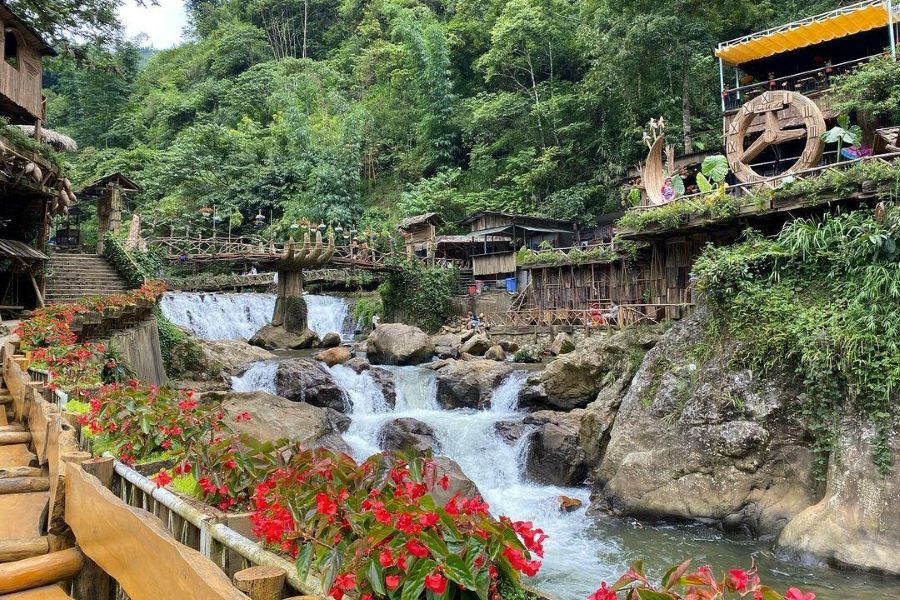Cat Cat Village – Explore Vietnam’s Hidden Cultural Gem
Tucked in the hills of Sapa, Cat Cat Village offers a captivating glimpse into Vietnam’s rich heritage, traditional crafts, and scenic beauty-an unforgettable cultural experience that’s even more rewarding when explored with a Cat Cat Village map to guide your way.
Whispers in the Highlands: Discovering Cat Cat Village
Nestled in the misty highlands of northern Vietnam lies a destination that quietly captivates those who find it. From Cat Cat Village to Fansipan, the journey reveals a side of Vietnam Travel that many visitors overlook-authentic, intimate, and steeped in culture. While Hanoi and Ha Long Bay often top the itinerary, few venture into the soul-stirring landscapes of Sapa, where this hidden gem awaits.
As seasoned travelers who have explored Vietnam time and again, we’ve wandered the cobbled trails of Cat Cat, sampled its earthy local cuisine, and connected with villagers whose traditions run deep through generations. In this article, we’ll go beyond the guidebooks to share real experiences and insider tips-so you can make the most of your journey through one of northern Vietnam’s most enchanting regions.

Cat Cat Village, a peaceful escape nestled in the heart of Sapa.
Geography and Location
Cat Cat Village is located just 2 kilometers southwest of Sapa Town, in Vietnam’s Lao Cai Province. Set at over 1,500 meters above sea level, it lies within the scenic Hoang Lien Son mountain range, surrounded by terraced rice fields, waterfalls and forested hills.
This Hmong village sits inside Hoang Lien National Park, making it a peaceful yet easily accessible destination for travelers. The short walk from Sapa offers panoramic views of Muong Hoa Valley and passes through lush countryside, local gardens and traditional homes.
The highland geography shapes the lifestyle of the local Hmong people, who have cultivated the steep hillsides for generations. Thanks to its elevated position, the village enjoys a cool mountain climate year-round.
Cat Cat’s unique location offers a balance of seclusion and convenience, making it a must-visit stop for anyone exploring the cultural and natural wonders of northern Vietnam.
The History Behind Cat Cat Village
Cat Cat Village was established in the 19th century by the ethnic group Mong, who migrated from southern China into northern Vietnam. Drawn to the area’s fertile land and fresh mountain streams, they settled in the Hoang Lien Son mountain range and built homes using wood, bamboo and stone-materials still used today.
Over generations, the Hmong people developed a rich culture centered around farming, textile weaving and nature-based spiritual beliefs. Despite modern influences, Cat Cat has preserved many of its traditional customs, including handmade brocade production, folk music and ritual ceremonies.
In recent decades, as tourism in Sapa grew, The village opened to visitors seeking authentic cultural experiences. While tourism has brought economic opportunity, the community continues to balance modern development with cultural preservation.
Today, This beautiful village offers a rare window into the daily lives of Vietnam’s ethnic minorities, rooted in both history and resilience.
The Cultural Heart of the Hmong People
Cat Cat Village is home to the Mong ethnic group, one of Vietnam’s largest and most culturally rich minorities. Known for their handmade textiles and spiritual bond with nature, the Mong have lived in this region for centuries. Their vibrant traditions, language and clothing reflect a deep respect for ancestral ways.
As we explored the stone paths, we saw Mong women carefully dyeing cloth in large pots of natural indigo. Children in embroidered outfits laughed and played along the narrow trails. Their homes, built from timber and raised on stilts, offer a quiet charm rooted in simplicity.

Cat Cat Village stands proud with the spirit of the Hmong people.
Despite growing tourism, the community proudly preserves its heritage. Locals often greet visitors with friendly smiles and warm invitations. Don’t be surprised if someone welcomes you in for tea or a quick chat.
To truly appreciate the culture, arrive early when village life is most active. The peaceful walk from Sapa town to the village takes about 45 minutes.
Interestingly, traditional items from the Mong ethnic minority group are being displayed at the La Rochelle Natural History Museum of France’s Nouvelle Aquitaine. This global recognition speaks to the value of a culture still thriving in the hills of northern Vietnam.
Best time to visit this beautiful village
Timing your visit can greatly affect your experience in Cat Cat Village. For the best weather and scenery, plan your trip during spring (March to May) or autumn (September to November). During these months, skies are clear and temperatures stay cool. The rice terraces turn a glowing green or gold, creating landscapes that feel straight out of a painting.
We visited once in early October, right in the heart of the harvest season. Farmers were gathering rice by hand and the fields were alive with movement. The scent of fresh-cut grass filled the air. These small moments bring depth to any trip and turn an ordinary stop into something memorable.
If you’re planning a Cat Cat Vietnam travel season getaway, consider aligning it with these months for the most vibrant experience. With the right timing, your journey through the hills of Sapa becomes not just scenic but deeply unforgettable.
Top Experiences in Cat Cat Village
There are countless ways to enjoy Cat Cat Village, whether you’re into history, photography or simply looking to connect with nature. Each experience offers a deeper look into the rich culture that defines Vietnam travel. Here are some highlights you won’t want to miss:
- Visit traditional Hmong houses to learn about daily life and see how ancient customs are still part of everyday living.
- Stop by Tien Sa Waterfall, often called Cat Cat Waterfall, where cool mist and quiet views create the perfect photo moment.
- Shop for handmade brocade crafted by local artisans-beautiful pieces that make meaningful and authentic souvenirs.
- Catch a cultural dance performance held at the central community house, typically around 10:30 AM and again at 3:00 PM.
- Taste local Cat Cat Village food like sticky rice cooked in bamboo, grilled meats and warm herbal teas.
- Walk the peaceful 3 km trail from Sapa town to the village, surrounded by rice terraces and mountain views.
The entrance fee is around 90,000 VND (about $3.50 USD) and covers access to waterfalls, shows and village attractions.
Adding these experiences to your Cat Cat Vietnam Tour Itinerary will bring depth and authenticity to your northern Vietnam journey.

In Cat Cat Village, Hmong houses reflect history carved in wood and stone.
A Scenic Stroll Through Sapa
For travelers who enjoy gentle adventures, a Sapa easy trekking tour offers the perfect mix of culture and scenery. These tours usually start in Sapa town and wind through Cat Cat Village and nearby minority hamlets. Along the way, expect endless mountain views, terraced fields and friendly encounters with local families.
The trails are mostly downhill or gently sloped, ideal for older visitors, families or anyone preferring a relaxed pace. Your guide will often share stories about the ethnic communities, explain traditional customs and point out native plants.
We joined a tour in late spring and were amazed at how peaceful yet rich the experience felt. Every bend in the trail brought a new photo opportunity.
Wear sturdy walking shoes, dress in layers and don’t forget a camera. If you’re planning a Sapa easy trekking tour, this route is the perfect way to explore at your own rhythm.
Where to Sleep and How to Make It Count
We recommend spending at least half a day exploring Cat Cat Village, but a full-day visit offers more time to enjoy its pace. For those seeking a deeper connection, staying overnight adds another layer to the experience. A Cat Cat Village homestay experience gives you a front-row seat to local life in the mountains.
Sapa offers various places to stay, catering to different comfort levels and travel styles. Here are a few popular options:
- Local homestays: Traditional wooden houses run by Hmong families. Includes home-cooked meals and activities like farming or cooking.
- Eco-lodges: Sustainable stays with mountain views and natural surroundings. Great for travelers who enjoy comfort and care for the environment.
- Guesthouses in Sapa town: Budget-friendly with easy access to restaurants and tour agencies. Ideal for short stays and solo travelers.
- Boutique mountain hotels: Stylish rooms with heating and private balconies. Perfect for couples or those looking to unwind in comfort.
Wherever you stay, the views are stunning and the hospitality always feels genuine.

Cat Cat Village offers eco-lodges where nature meets comfort in perfect harmony.
Getting to Cat Cat Village
Reaching Cat Cat Village is part of the journey that makes Sapa so memorable. Located just two kilometers from Sapa town, it’s easily accessible whether you walk or drive. The path downhill offers sweeping views of terraced rice fields and mist-covered mountains at nearly every turn.
If you prefer a relaxed journey, joining a Sapa tour 2 days 1 night by car is a convenient option. The ride takes you through quiet backroads and charming villages, giving you time to take in the changing scenery. It’s a comfortable choice for families, older travelers or anyone short on time.
For more flexibility, consider booking a Vietnam car rental with driver. This lets you explore at your own pace with the added benefit of local knowledge. Drivers often point out hidden viewpoints or cultural sites along the way, turning a simple transfer into a richer experience.
Respecting Local Traditions
As visitors, we step into a way of life that has existed for generations. Following a few respectful habits helps protect the spirit of Cat Cat Village. These Cat Cat Village travel tips will help you connect more meaningfully with the community:
- Ask before taking photos of people to show respect for personal space and cultural boundaries.
- Avoid touching sacred items or religious objects often found in homes or village altars.
- Dress modestly to show consideration, especially when entering someone’s home or attending a community gathering.
- Use simple local phrases in Vietnamese or the Hmong dialect to build connection and goodwill.
- Bring small gifts like snacks or school supplies if visiting a home, though never offer money to children.
- Walk gently through the village, stay on paths and avoid stepping into crops or restricted areas.
Respectful actions leave a positive impact and help preserve the charm for future travelers.
Plan Your Visit With Confidence
If you’re planning a trip across Vietnam and looking for a balance between cultural depth and natural beauty, Cat Cat Village is an essential stop. It offers something rare: a chance to step back in time and witness a way of life still deeply connected to nature and tradition.
Whether you’re customizing your own adventure or joining a Vietnam tours package , make sure Cat Cat is part of your journey. And if your itinerary includes the 10 days highlights of the North Vietnam tour, this village will easily be one of your favorite moments.
For those who appreciate hands-on experiences and real cultural immersion, Cat Cat Village feels like more than a destination-it feels like a privilege.
FAQs
Start planning your tailor-made Vietnam tour by contacting one of our specialists…







